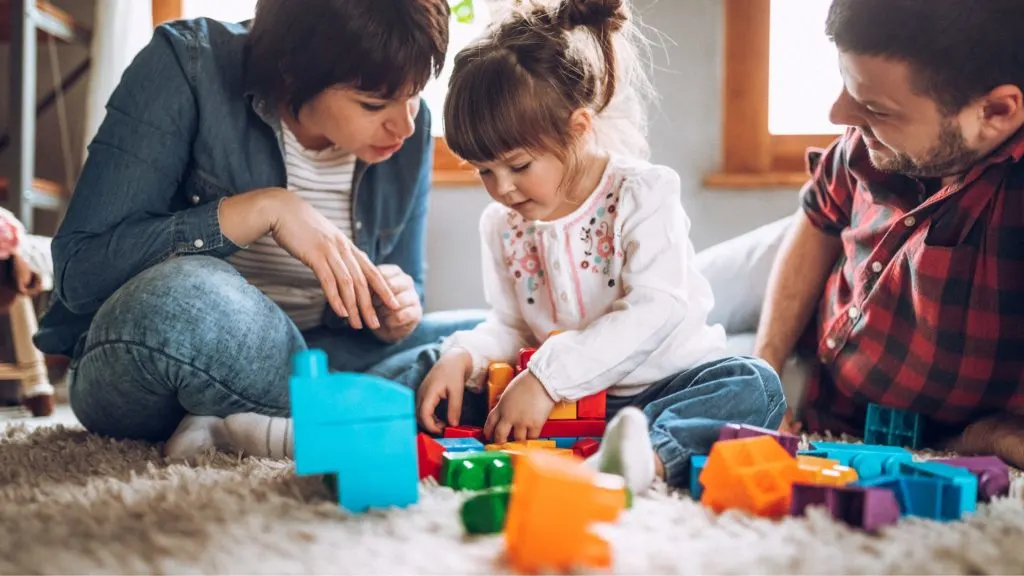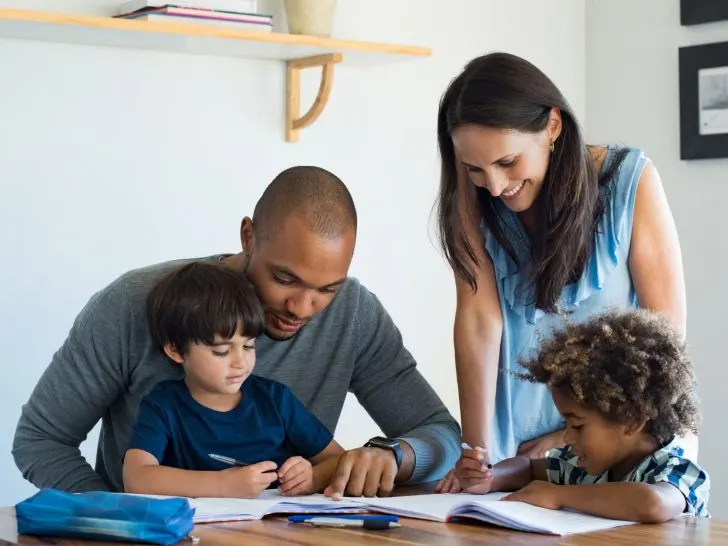Parenting is often characterized by a range of styles, each with its own approach to raising children and establishing family dynamics. In this article we will first go through parenting styles defined by experts, analyze the effects, and discuss the positives and negatives. Four primary parenting styles are widely recognized: authoritative, authoritarian, permissive, and uninvolved. But, the main goal of this article is not just to teach you about general parenting styles, in the end I will go through five different approaches to shift household dynamics that will keep everyone more calm.
Research into parenting styles has evolved over time, revealing that the way you parent is not merely a reflection of cultural practices or individual preferences, but has measurable effects on a child’s future. Developmental psychology has shown that children’s behavior evolves over time based on specific parenting practices. We can argue nature versus nurture until the end of time, but your child’s temperament can and does change based on how you parent.
Skip to:
- Authoritative Parenting Style Defined
- Authoritarian Parenting Style Defined
- Permissive Parenting Style Defined
- Neglectful Parenting Style Defined
- What Influences Parenting Styles
- 5 Parenting Strategies to Save Your Sanity
- New Parenting Trends to Consider
What Type of Parent am I?
In college my major was psychology, which would lead many people to believe I would have some sort of edge to be a better than average parent. But, in reality I would say I do spend a fair bit of time simply being a reactive parent. I often find myself thinking that parenting books about child behavior must be written by people who don’t have kids.
The idealistic outcomes of different parenting styles borderline on comical to me. No matter how many research methods or case studies claim that specific behaviors will change if you follow defined parenting styles, the reality is that all kids are different.
I will also add that claims parents make about their family dynamics, parenting style, and child behavior outcomes are extremely unreliable because of fear of judgement. Would I like to think I create a structured, high expectation, high nurturing environment for my kids? Sure, I would like to think that. But, how much time is actually spent in yelling matches with my pre-teen daughter? Enough that I am certainly not going to pretend I am some perfect role model of parenting.
Instead, I am going to teach you what I know about parenting styles defined in layman’s terms and break down how that information can help you become a better parent. Then, based on my own parent observations in numerous cultures outside of the United States I will give you five ideas you can try to curb the endless frustration of parenting in the modern age.
No grandstanding or fancy degrees in this article, just ideas about how to do better next time a parenting grievance starts to make you question your sanity.
Historical Overview of Parenting Style Defined
The evolution of parenting styles in psychological research mirrors the growing understanding of child development. Your appreciation for these framework shifts will deepen by examining seminal work and progressive expansions in the field.
Developmental Psychologist Diana Baumrind
Diana Baumrind, a developmental psychologist, was instrumental in identifying three main styles of parenting in the 1960s. Authoritative parenting combines high demands with high responsiveness, fostering an environment of warmth and structure. In contrast, authoritarian parenting is characterized by strict rules and high expectations with little parental responsiveness. Lastly, permissive parenting is defined by high responsiveness but limited control, often leading to fewer boundaries.
- Authoritative: High expectations, high responsiveness, structured
- Authoritarian: High expectations, strict rules, low warmth
- Permissive: High warmth, few rules, low expectations

Expansion of Parenting Style Defined
Further research introduced a fourth parenting style, uninvolved, marked by low responsiveness and low demands, often resulting in a lack of nurturance and structure. This expansion of parenting styles provides you with a more nuanced understanding of the various approaches and their potential impact on child development.
As research continued, it became clear that cultural norms heavily influence parenting behaviors and perceptions. The western-centric view of authoritative parenting as optimal does not necessarily align with parenting philosophies globally, suggesting the need for a culturally sensitive framework when considering parenting styles.
Authoritative Parenting Style Defined
Modern day parenting influencers and other parent role models in positions of power typically display authoritative parenting style at least as far as their public portrayal of their family dynamics. If anyone bothered to pull back the curtain with child reports or truthful parent interviews you might be surprised to find out that there are a lot of untold elements of their family life.

Characteristics of Authoritative Parenting
Authoritative parenting is characterized by a high degree of parental responsiveness to your child’s emotional needs while also maintaining high expectations for behavior and maturity. This style is proactive and can be broken down into distinct traits:
- Clear Communication: You provide clear guidelines and expectations that are developmentally appropriate.
- Consistent Discipline: The discipline you apply is fair and consistent, not arbitrary or harsh, and is aimed at teaching rather than punishing.
- Warmth and Nurturance: Showing unconditional love and warmth supports your child’s psychological and emotional development.
- Encouragement of Independence: While providing guidance, you allow your child appropriate freedoms and encourage self-reliance to foster independence.
Effects of Authoritative Parental Control on Child Development
The expected impacts of authoritative parenting on child development are significant:
- Social Skills: Children of authoritative parents are found to have well-developed social skills and are often viewed as socially competent by their peers.
- Academic Success: There is a strong correlation between authoritative parenting and higher academic performance as the supportive yet structured environment fosters a focus on learning.
- Behavioral Regulation: Effective discipline within this parenting model teaches children behavioral self-regulation and can lead to lower instances of behavioral issues.
- Self-Confidence: Exposure to this balanced parenting approach can instill a sense of self-assuredness and self-esteem as children navigate through different developmental stages.
- Problem-Solving Skills: When you engage in authoritative parenting, you provide the social support necessary for a child to develop strong problem-solving skills.
Authoritarian Parenting Style Defined
When you think of the authoritarian parenting style, it forcefully blends high expectations with low flexibility. This approach to parenting traditionally emphasizes strict rules and behavioral control, often resulting in a one-way street of communication from parent to child.

Features of Authoritarian Style
- High Behavioral Control: You maintain firm control over your child’s behavior with little room for dialogue or feedback. Your rules are clear and non-negotiable.
- Strict Rules: Your household operates on established guidelines that you expect your child to follow without question.
- Low Responsiveness: Emotional support and responsiveness are often minimal. Your focus leans toward obedience over nurturing.
Consequences of Authoritarian Parenting
- Impact on Child Outcomes: Children may exhibit compliance in the short term, however, this strict, unidirectional style could potentially lead to issues like low self-esteem and reduced decision-making skills.
- Behavioral and Emotional Effects: Over time, the stringent expectations and lack of emotional warmth can result in children who are less independent and harbor feelings of resentment or anger.
By understanding these core ideas, you can reflect on how authoritarian parenting might shape the environment in your home and the development of your child.
Permissive Parenting Style Defined
In discussing permissive parenting, you encounter a style that features high responsiveness to a child’s needs with minimal demandingness or enforcement of rules.
Indicators of Permissive Parenting
Permissive parenting, also known as indulgent parenting, is characterized by parents who are nurturing and communicative but offer few boundaries or discipline structures. When you approach parenting with this style, you might:
- Set limited rules and guidelines: Your expectations for your child’s behavior are typically minimal and not strictly enforced.
- Use little punishment: Consequences for undesirable behavior are rare, often leading to an environment with a lack of structure.
- Act as a friend more than an authority figure: You may prioritize being liked and maintaining a friendly relationship over establishing a traditional parent-child dynamic.
- Resist exercising psychological control: Your parenting is more about acquiescence than influencing children’s emotional and psychological development through defined expectations.

Outcomes for Children of Permissive Parents
Research suggests that children raised by permissive parents might exhibit certain behaviors and developmental outcomes. As a parent with this approach, you might notice:
- Less self-discipline: Children might struggle with self-control and the ability to delay gratification.
- Social challenges: There can be difficulties in social interactions due to the lack of boundaries at home.
- Higher levels of self-esteem: The child might display increased self-confidence due to the parent’s constant affirmative support.
- More creativity and spontaneity: A permissive environment often fosters these traits as children feel free to express themselves without much restriction.
Neglectful or Uninvolved Parenting Style Defined
The fourth style is where a child’s own parents rarely tackle any issues with their psychosocial development or health problems. All the other types of parenting styles could be lumped together as parentings who are trying to be good parents, whereas this parenting style simply doesn’t engage in the elements of parenting a “normal” parent would.
Signs of Uninvolved Parenting
- Lack of Responsiveness: You might be an uninvolved parent if you rarely or never respond to your child’s emotional needs. Children may often feel that their feelings and problems do not matter to their parents.
- Minimal Supervision: Children of neglectful parents typically receive little guidance or supervision. They may have to make decisions that are beyond their age-appropriate abilities.
Impacts on Children of Neglectful Parents
- Emotional Consequences: Children raised by uninvolved parents often struggle with self-esteem issues and may develop feelings of worthlessness.
- Social and Academic Challenges: These children might experience difficulties in forming relationships and often perform poorly in school due to the lack of encouragement and support from their parents.
Your efforts to increase involvement in your child’s life and to be responsive to their needs can help alleviate the detrimental effects associated with uninvolved parenting. Being present both emotionally and physically is crucial in supporting your child’s growth into a healthy and well-adjusted individual.
Influences on Parenting Style Defined
Your parenting practices are not developed in isolation, they are significantly influenced by both socioeconomic factors and cultural influences. These characteristics shape your approach to raising children, often unconsciously.

Socioeconomic Factors
Your socioeconomic status (SES)—which includes your income, education level, and occupation—has a tangible impact on your parenting style. A higher SES typically affords more resources and opportunities for children, and may influence a more authoritative style, which the American Psychological Association suggests is associated with nurturing, responsive, and supportive parenting, yet with clear boundaries.
- Income: Affects the type of activities and educational resources you can provide.
- Education: Tends to influence how you value and support your child’s educational development.
- Occupation: Can affect the amount of time you have to spend with your child, as well as the values and behaviors you model.
Cultural Influences on Parenting Style Defined
Cultural norms play a significant role in shaping parenting practices. In Chinese culture and Japanese culture, for instance, there is often a stronger emphasis on respect for authority and academic achievement, which can lead to a more authoritarian approach to parenting—characterized by high expectations and less emotional warmth compared to the authoritative style.
- Cultural Norms: These are the shared expectations and rules that guide behavior in a society, affecting how you discipline and reward your children.
- American Psychological Association: Offers insights into how parenting styles align with children’s psychological development within the context of varying cultural backgrounds.
By recognizing the influence of both socioeconomic factors and cultural influences, you can better understand the background and motivations behind different parenting practices.
Parenting Styles and Child Outcomes
Your approach to parenting has a profound impact on various aspects of your child’s development. These effects are wide-ranging, influencing not only academic and behavioral outcomes but also physical and mental health.
Academic and Behavioral Outcomes
- Authoritative Parenting: You foster independence and discipline in your child, which is associated with higher academic performance. An emphasis on clear communication and reasonable expectations tends to produce children who exhibit lower levels of problem behavior and have better social skills. This is one of the disciplinary methods used by those with high parental demandingness.
- Authoritarian Parenting: Authoritarian parents have strict rules and high expectations might lead to obedience, but can suppress creativity and may result in higher levels of problem behavior.
- Permissive Parenting: If you’re more lenient, your child might have more freedom but could struggle with self-discipline, often translating to poorer academic outcomes.
- Uninvolved Parenting: Minimal involvement from you might lead to your child having the worst outcomes academically, as there is often an absence of guidance and support.
Physical and Mental Health
- Authoritative Parenting: This balanced approach promotes better physical health due to active engagement in a child’s nutritional and physical activity needs, and better mental health outcomes, as emotional needs are addressed.
- Authoritarian Parenting: While your children might comply with your rules for physical health, the lack of emotional support can contribute to mental health issues.
- Permissive Parenting: Limited guidance from you can lead to erratic physical health habits. A lack of boundaries may correlate with mental health struggles due to an absence of structure.
- Uninvolved Parenting: Your detachment can contribute to neglect in both physical and mental health needs, often resulting in poor health outcomes for your child.
Parenting Strategies for Your Sanity
#1 Establish a ‘Yes’ Space
Understanding the ‘Yes’ Space
Picture this: A special zone in your home where your kids are free to explore, play, and learn. This is your ‘Yes’ Space. It’s all about saying yes to fun and exploration, and no to constant supervision. You’re creating a safe haven where your little ones can thrive, and you can catch your breath.
- Why It Works: In a ‘Yes’ Space, kids enjoy freedom within safe boundaries. This boosts their confidence and independence.
Creating Your ‘Yes’ Space:
Let’s set up this magical spot:
- Choose the Right Area: It could be a corner in the living room or a section of their bedroom. Anywhere you can keep an eye on them without being right there.
- Safety Check: Clear out anything risky. Think sharp objects, breakables, or small choking hazards.
- Fill it with Fun: Add items that encourage play and learning. Soft mats, puzzles, blocks, and colorful books are perfect.
- Tip: Keep it fresh! Rotate toys and books to maintain their interest.

Fostering Independence and Safety
In your ‘Yes’ Space, your kids learn to make decisions in a safe environment. They get to test their limits and learn from their choices. And you? You get to relax a little, knowing they’re in a secure, engaging place.
- The Result: Kids who play in a ‘Yes’ Space learn to entertain themselves and handle freedom responsibly. For you, it’s a stress-reliever and a joy to watch.
This ‘Yes’ Space isn’t just a play area, it’s a tool for growth and peace in your hectic parenting life. It’s where your kids learn, you relax, and everyone wins. Try it out and watch the magic happen!
#2 Routine, but Flexibility
The Power of Routine
Imagine a day where things just flow. That’s the power of a solid routine. Kids know what to expect and that brings a sense of security. Breakfast, playtime, nap, repeat – a predictable pattern keeps chaos at bay.
- Consistency is Key: Regular meals, playtimes, and bedtimes create a comforting rhythm for your kids.
Embracing Flexibility
But hey, life’s full of surprises, right? Sometimes, routines need a little wiggle room.
- Unexpected Changes: Maybe there’s a surprise visit from grandparents or a sudden rainstorm spoils a park trip. Adapt and go with the flow.
- Teach Adaptability: Use these moments to teach your kids how to handle changes gracefully.
- Balance is Everything: Stick to the routine, but don’t stress if things go off track now and then.
- Tip: Have a backup plan. Rainy day? Indoor treasure hunt!
Balancing Structure and Spontaneity
It’s like a dance. Structured steps with room for a few freestyle moves. You’re teaching your kids that while structure is good, adapting to changes is also important.
- The Benefit: Kids learn to be flexible, and you learn to handle disruptions without stress.
So, there you have it. Routines are your backbone, but flexibility is your secret weapon. Keep this balance, and you’ll navigate the parenting journey with a bit more ease and a lot more joy!
#3 Mindful Moments
Introducing Mindfulness to Kids
Imagine a home filled with calm, even amidst the whirlwind of parenting. That’s what mindfulness brings. It’s about being present and aware, both for you and your kids. This practice can transform stress into serenity.
- Start Simple: Breathing exercises or short nature walks. Easy, right?
Activities for Family Mindfulness
Let’s get the whole family involved. Here are some fun, calming activities:
- Family Yoga: A gentle way to stretch, breathe, and connect.
- Mindful Eating: Savor each bite during meals. Talk about the flavors, textures, and smells.
- Gratitude Moments: Share one thing you’re grateful for each day. It’s a positive, reflective practice.
- Tip: Make it a regular part of your day. Maybe after dinner or during a weekend morning.
Emotional Regulation and Connection
Mindfulness isn’t just about being calm; it’s about emotional learning. Your kids learn to recognize and manage their feelings. You learn to respond rather than react. It’s a journey of emotional growth for the whole family.
- The Outcome: A stronger, more connected family. Kids who are emotionally aware and parents who can handle the ups and downs with grace.
Mindful Moments are your secret to a peaceful, connected family life. They teach patience, understanding, and emotional intelligence. Try them out, and feel the difference in your family dynamics!

#4 Tech-Free Time
The Impact of Technology on Family Life
In a world where screens are everywhere, it’s easy to get lost in digital noise. Tablets, TVs, phones – they’re useful, but they can create distance in a family. Tech-Free Time is about reconnecting with each other, away from digital distractions.
- Why It Matters: Unplugging helps deepen family bonds and encourages healthier activities.
Implementing Tech-Free Periods
Ready to go screen-free? Here’s how to make it happen:
- Set Clear Times: Maybe during dinner or an hour before bed. Consistency is key.
- Everyone Joins In: It’s not just for kids. Parents, you’re in this too.
- Explain the Why: Help your kids understand the benefits of taking a break from screens.
- Tip: Replace screen time with something fun. Board games, storytelling, or a family walk.
Alternative Activities and Family Bonding
What to do when the screens are off? That’s when the real fun begins. Consider taking a device free family vacation.
- Get Creative: Draw, paint, or build something together.
- Explore Outdoors: Nature walks, bike rides, or just playing in the park.
- Family Projects: Cook a meal together or start a small garden.
I’ve written several articles about fun family games to play at home and diversity activities for kids if you need ideas for ways to fill the time. But, it’s honestly not as important what you do, just that you do it together as a family.
- The Result: Tech-Free Time isn’t just about turning off screens, it’s about turning on life. It’s about laughter, conversation, and making memories.
Remember, Tech-Free Time is a powerful tool for modern families. It’s about finding balance in our digital world and rediscovering the joy of being together. Give it a try, and watch your family grow closer, one screen-free moment at a time!
#5 Parental Time-Outs
Recognizing the Need for a Break
Here’s a truth bomb – parenting is intense. Sometimes, the best thing you can do is step away for a moment. Recognizing when you need a time-out is crucial. It’s not about escaping, it’s about recharging.
- Signs You Need a Break: Overwhelm, irritation, or just feeling drained. Listen to these signals.
Effective Parental Time-Outs
Taking a break is an art. Let’s perfect it:
- Short and Sweet: Even five minutes can work wonders. A quick walk, a cup of tea, or just sitting quietly.
- Communicate: Let your family know you need a short break. It’s healthy for them to see you prioritizing self-care.
- Guilt-Free: Remember, taking time for yourself isn’t selfish. It’s necessary.
- Tip: Find what soothes you. Maybe it’s music, a book, or some deep breaths.
Modeling Stress Management for Kids
Your time-out is more than just a break. It’s a teaching moment. Kids learn from what they see. When they watch you manage stress in a healthy way, they learn to do the same.
- Beyond the Break: Come back refreshed and ready. You’ll be more patient, more present, and more playful.
Parental Time-Outs are your secret superpower. They help you stay centered and calm, ready to dive back into the wonderful chaos of parenting. Embrace them as part of your parenting toolkit, and see the positive ripple effect on your family. Here’s to happier, healthier parenting!
Emerging Trends in Parenting
As you navigate the landscape of modern parenting, you’ll encounter a variety of styles that reflect the evolving values and challenges families face today.
Modern Parenting Style Defined
- Helicopter Parenting: You may be aware of this involved style where parents closely monitor and involve themselves in nearly all aspects of their children’s lives. The intent is often to protect and guide, but it may inadvertently lead to reduced independence and resilience in children.
- Tiger Parenting: This term describes a strict or demanding approach. You might associate it with high expectations and structured environments aimed at fostering successful and disciplined individuals. However, the high standards can put too much pressure during their early childhood.
- Free-Range Parenting: In contrast, free-range parenting encourages your child’s independence by allowing them to experience the world with less supervision, granting them the freedom to learn from natural consequences. This style foster individuality that results in people making the best possible decisions during their early adulthood. It is consistently written about as the best parenting style and most child psychologists in America suggest it.
- Attachment Parenting: This nurturing parenting approach emphasizes forming a strong emotional bond with your child, ensuring that you are sensitive and responsive to their needs. However, this results in the children’s needs becoming the primary focus of the caregiver instead of well-being of everyone in the family.
- Snowplow Parents: Similar to helicopter parents, if you identify as a snowplow parent, you actively push obstacles out of your child’s path, aiming to make their journey through life smoother.
Amid these patterns, a new parenting style may be emerging, which balances mental health, empathy, and the importance of adapting to each child’s unique needs.
The Role of Social and Parental Support
- Social Support: It’s essential for you to recognize the value of a robust social support network that includes family, friends, and community resources. Such support can help parents deal with the stresses of child-rearing and provide a soundboard for shared experiences and advice.
- Parental Support: A critical aspect of successful parenting involves the behavioral control and support you give to your child. Effective parental support combines affection, attention to well-being, and the guidance necessary for your child to grow into a well-adjusted adult.
By adapting to modern challenges and integrating social and parental support, you can effectively guide your child through their development while fostering a nurturing and responsive family environment.




Leave a comment